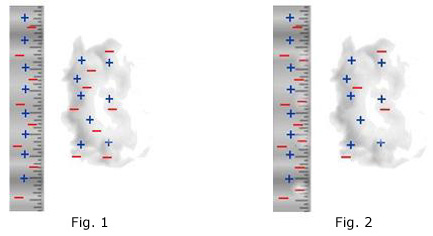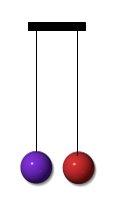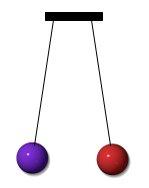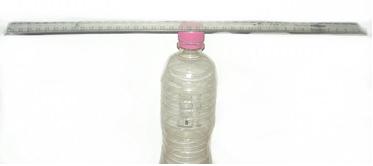This focus idea is explored through:
Contrasting student and scientific views
Student everyday experiences
 Students have many experiences such as putting batteries in devices correctly and ‘recharging’ batteries that have gone ‘flat’ that lead students to construct meanings for these terms. These meanings are often very closely linked with particular experiences.
Students have many experiences such as putting batteries in devices correctly and ‘recharging’ batteries that have gone ‘flat’ that lead students to construct meanings for these terms. These meanings are often very closely linked with particular experiences.
Many students will have experienced small but memorable electric shocks as a result of ‘static electricity’ when getting out of a car on a warm, dry day or deliberately scuffing their shoes across synthetic carpet and touching a metal door handle or each other. Some students will also have played with using ‘static electricity’ to attract or repel very light objects, e.g. picking up small pieces of paper or attracting their hair with a rubbed plastic comb or ruler.
Students often do not link events that involve receiving an electric shock (e.g. playing on a trampoline mat), with similar events that involve static electric attraction, (e.g. observing clinging clothes that emerge from a tumble dryer or sugar grains that are attracted to the inside surface of a plastic container when shaken). For younger students these events are not connected by the common idea of their ‘electrostatic’ origins and student may not make this link without encouragement.
Understandably, many younger students do not see the need to discriminate between electrostatic forces and magnetic forces. To them, these appear to be common experiences of the same non-contact force. For example, a balloon ‘rubbed’ with a cloth resulting in its attraction to a ceiling is frequently described confusingly by students (and some adults) as ‘magnetized’ in some way.
For many students, the dramatic observation of a lightning discharge is one of their most memorable experiences of ‘seeing’ the effects of the movement of large amounts of electrical charge, although this experience is often incorrectly attributed to other phenomena.
Research: Benseghir & Closset (1996), Guisasola (1995), Harrington (1999), Henriques (2000), McIntyre (1974), Park, Kim, Kim & Lee (2001), Seroglou, Koumaras & Tselfes (1998)
Scientific view
Attraction and repulsion of electric charges is one of three fundamental non-contact forces in nature. The others are magnetism and the force of gravity (see the focus idea
Forces without contact).
There are only two different sorts of known charge which scientists have labelled as ‘positive’ and ‘negative’. These names were chosen historically to indicate that they were somehow ‘opposites’ of each other, to help emphasise the two different observable forms. Scientists do not know exactly what charge is or how the two sorts of charge differ from one another; however each affects itself and its opposite form.
Positive and negative charged objects attract or pull each other together, while similar charged objects (2 positives or 2 negatives) repel or push each other apart. The charged objects do not need to be touching in order for the repulsive or attractive forces to be experienced between them; i.e. they can be observed to affect each other at short distances and without the need for any substance in between, e.g. air.
When an object made of a good electrical insulator like plastic or glass is rubbed vigorously with another flexible electrical insulator made from fur, cotton or wool it is possible for charge of one type to move from the surface of one insulator to the surface of the other. In Fig 1 below, before rubbing each item is electrically balanced. In Fig 2 below, after rubbing the plastic ruler has become negatively charged and the cotton positively charged. The rubbing does not create charges, but redistributes the charge between the two objects. As a consequence of their different overall charge, the two surfaces when separated will attract each other.
Charged objects can be created by using alternative methods to rubbing or sliding but all need the two surfaces to be in close contact and then separated. Other examples are peeling two plastic sheets apart or removing adhesive tape from a sheet of glass. Charged objects will also influence all other small ‘non-charged’ objects to become partially oppositely charged when they are brought near to them. This causes them to be attracted to each other. For example, a charged comb will attract small objects such as grains of sugar when brought close to them. If the grains of sugar come into contact with the comb then in a little while some of the grains will gain the same charge as the comb and will be rapidly repelled.
The amount of charge on the surface of any object will slowly reduce with time as the charge is eventually conducted away by water vapour in the surrounding air. For example a charged balloon will eventually fall from the ceiling as its charge diminishes.
Natural displays of charge movement like lightning mostly occur in storm clouds and less frequently above erupting volcanoes or in dust storms. In storm clouds, the charge is redistributed unevenly (parts will be positive and other parts negative).This imbalance can build up to the point where air becomes a conductor, and the imbalance is reduced by a rapid spark within the cloud or to the Earth. This is the lightning flash we see. The thunder we often hear is the result of this powerful spark rapidly heating the air.
Scientists are still trying to find out precisely why the imbalance of charge is created in storm clouds.
See the websites listed in the
Further resources section for more information.

Critical teaching ideas
- Electrostatic forces are non-contact forces; they pull or push on objects without touching them.
- Rubbing some materials together can result in something called ‘charge’ being moved from one surface to the other.
- Charged objects pull on other uncharged objects and may either push or pull on other charged objects.
- There are two sorts of charge; scientists do not know exactly what charge is or how the two sorts of charge differ; they call the two sorts ‘positive’ and ‘negative’.
- Lightning is the result of rapid charge movements in storm clouds.
 Explore the relationships between ideas about charge and non contact forces in the
Concept Development Maps – Electricity and Magnetism
Explore the relationships between ideas about charge and non contact forces in the
Concept Development Maps – Electricity and Magnetism
At this level, the prime focus should be on encouraging students to observe and explore electrostatic phenomena through play, leading to the development of simple explanations for the observed attraction and repulsion of charged objects. Students should be encouraged to discriminate between electrostatic forces and magnetic forces as different examples of non-contact forces.
The inclusion of activities that involve the rubbing of
two similar plastic objects with the same material is important, as it is only in these cases that you can see the two similar charged objects pushing each other apart as a display of the repulsion of like charges.
A central idea for students to understand is that electrostatic forces are non-contact forces; it is not important at this level to emphasise to students that ‘like charges repel and unlike charges attract’. It is more appropriate to demonstrate that charged objects attract uncharged objects, and can either attract or repel other charged objects.
Try to focus student attention on everyday ‘electrostatic’ experiences. These usually involve one object being charged by rubbing and another object that has not. Rubbed plastic combs and rulers attracting pieces of paper are commonly used examples but student investigations should not be limited to just these.
The ideas students will bring to this area are both varied and mostly not very strongly held. Using demonstrations and asking students to predict what may happen will usually be strong approaches for identifying students’ existing ideas of electrostatics at this level.
Research: Guisasola (1995), McIntyre (1974)
Teaching activities
When there is a lot of moisture in the air (such as when the weather is humid, and/or it is raining) it is very hard to create the electrostatic effects and experience the results described. Plan to attempt these activities when the weather conditions are warm and dry.
Open up discussion via a shared experience
 Consider using a Predict-Observe-Explain activity to prompt discussion. In a still, warm room, fully inflate a circular balloon and hang it from the ceiling or a roof truss using a long length of nylon thread (or fine fishing line).
Consider using a Predict-Observe-Explain activity to prompt discussion. In a still, warm room, fully inflate a circular balloon and hang it from the ceiling or a roof truss using a long length of nylon thread (or fine fishing line).
Now rub the balloon using a piece of wool/synthetic material or a jumper so that it becomes charged. Ask the students to predict what will happen if you bring the material or jumper you used to rub it near to the balloon.
The rubbing material will have a different charge to the balloon as charge moves from one object to the other. The balloon and the rubbing material should pull each other together showing an attractive force.

Now add another balloon so that it hangs near to the first. Once again rub each balloon with the same piece of wool/synthetic material or the jumper you are wearing. They should now become similarly charged. Stand well back and you and the students will see the two balloons separate as they attempt to repel by pushing on each other.
Have the students predict if changes will occur as time passes. Will the positions of the balloons change? Student should be guided to recognise that the balloons will slowly lose charge and move closer together as the charge decreases with time.
Challenge existing student views
Again using an inflated balloon, suspend it as before on a length of fine cotton or fishing line. Do not attempt to rub or charge the balloon in any way. Now ask the students to predict what will happen when you bring a bar magnet near to the balloon.
It is useful to accept any suggestions about different ways of bringing the magnet near the balloon (e.g. “Try the magnet the other way round.” “Hold it flat near the balloon.”). It is probable that many students will predict the balloon and magnet will be attracted (and so will likely want to try the magnet near the balloon in different ways when they first see no effect). However very few students will have any reasons to support this prediction – for most students, attraction is predicted because they have not ever differentiated magnetic and electrostatic forces. Do not use a charged balloon because it will be attracted to most uncharged objects and this may wrongly reinforce the student’s predictions.
Provide an open problem to be explored via play or through problem solving
Give a balloon to every member of the class. Challenge the students to make their balloon remain attracted to the ceiling for the longest time. Students will need to inflate and charge their balloon choosing one of a number of synthetic materials provided for the purpose. Consider having the students measure the time with stopwatches up to the point at which the balloons fall.
Encourage students to think about the following to achieve success:
- How big should they inflate the balloon? Will it make any difference?
- What type of material should they use to rub (charge) their balloon?
- How long should they try to rub or charge the balloon before their attempt?
- What shape of balloon should they select – circular or sausage shaped? Will this make a difference?
Approaches to this activity can vary. Students may choose to play with the materials and discuss their experiences later. They may also be encouraged to select one question and explore this systematically.
Provide a range of synthetic materials and natural materials like fur and cotton offcuts for the students to select from and trial. Consider also using circular and sausage shaped balloons.
Open discussion via a shared experience
Another demonstration that will show the same effects as the balloons requires two clear plastic rulers and a small plastic bottle (water or soft drink – a bottle with a lid that is 2-3 centimetres wide). Rub one ruler with wool (if you are wearing a woollen jumper, rubbing the ruler quickly under your armpit is very effective), and balance it on the bottle lid. Now rub the other ruler, and bring the rubbed end of this second ruler near to the rubbed end of the first ruler. You will see the ruler on the drink bottle rotate away from the second ruler because the two rulers are similarly charged and push each other away. If you bring the oppositely charged ‘rubbed’ wool near one of the rulers they will attract each other.

One way of stimulating discussion would be to demonstrate this activity and then challenge students to find connections to the activity involving charging two balloons above.
Focus students’ attention on overlooked detail
Collect a wide range of simple household items where electrostatic forces can be seen to be in operation. These can be explored in the classroom with small groups of students.
 Examples of household items could include:
Examples of household items could include:
- a number of plastic bottles containing small quantities of lightweight items such as hundreds and thousands cake decorations, fine dry sugar grains, psyllium husks or puffed rice. Have the students shake the containers, causing the contents to become charged as they brush on the inside walls of the container to which they are attracted.
- a number of plastic bottles containing small quantities of lightweight items such as hundreds and thousands cake decorations, fine dry sugar grains, psyllium husks or puffed rice. Have the students shake the containers, causing the contents to become charged as they brush on the inside walls of the container to which they are attracted.
Clarifying and consolidating ideas for communication to others
Following the students’ investigations of household items they can then be encouraged to report back to the class on their findings. This could be done using short presentations which identify any related observation of electrostatic forces in action. The investigation could be extended to include students writing short sentences describing what they observe and drawing labelled diagrams of the items and the observed effects. Students could be asked to find examples of electrostatic experiences at home which can be shared at school. It may be helpful if students can bring pictures or drawings they could share.